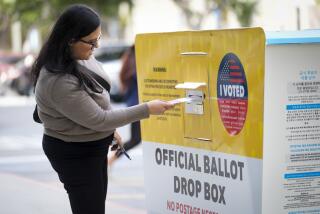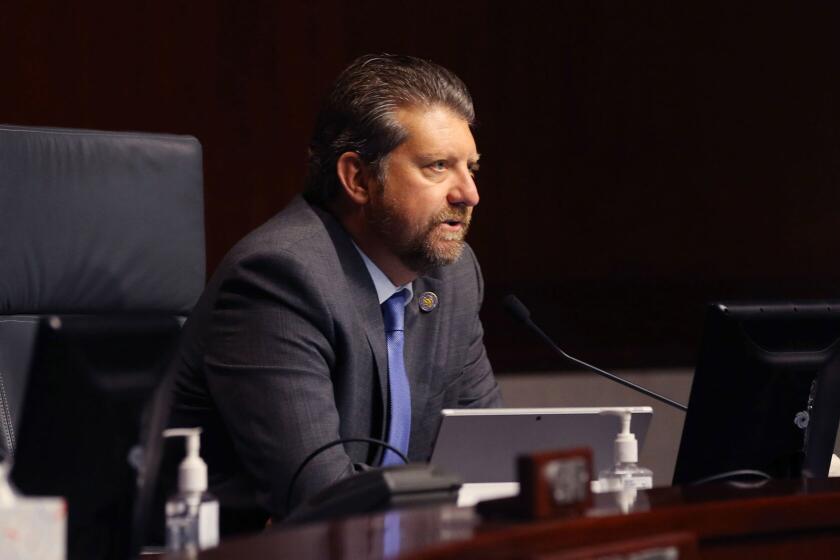Costa Mesa Compiles List of Needs After Success at the Polls
- Share via
Costa Mesa officials Wednesday began drawing up lists of needed street and sidewalk improvements following Tuesday’s decision by voters to allow the city to keep $2.1 million that otherwise would have been credited against future property tax bills.
“We’re in the process of putting together a list of 30 to 60 street projects that could go out to bid,” said Bruce Mattern, Costa Mesa public services director. “But we’ll be spreading money throughout the entire city.”
Passage of Measure C, the initiative to override the so-called Gann spending limit, was adopted 63.3% to 36.6%. The city became the first in Orange County to pass such an override, joining eight other California cities that previously have done so.
Measure C was endorsed 4 to 1 by City Council members and also was supported by local civic and business groups. There was no organized opposition except through letters published in area newspapers.
Had the measure failed, the council planned to credit property owners at the rate of $44 per $100,000 of assessed value or about $66 for a typical $150,000 house.
Mayor Donn Hall said he was “very pleased” by the measure’s passage. “It’s confirmation by the voters of their belief that the city will use those funds for the benefit of the community.”
Councilman Dave Wheeler, who had urged Costa Mesa residents to vote “No” and “take the money” as compensation for traffic woes, said the results didn’t surprise him. “There was organized support from the development community and the Chamber of Commerce and these things almost always pass anyway,” he said.
“The real effect will be seen when (council members) allocate the money next year. The question is whether they will add the money in the measure to the $4 million that they probably would have budgeted for the same projects next year any way,” Wheeler said.
The city staff has a list of about 4,400 sites in need of repair or reconstruction, but Mattern said the City Council will have final say over priorities.
The most serious street, sidewalk and parkway problems can be found in older established neighborhoods near Santa Ana Avenue and Del Mar Avenue, the Freedom Homes tract south of 17th Street, the Mesa Verde area south of the San Diego Freeway and the Republic Homes tract on the city’s west side, he said. Others include the area around 19th Street and Whittier Avenue and the neighborhood near South Coast Plaza by Fuchsia Street and Azalea Drive.
A list of staff-recommended street resurfacing and parkway projects is expected in two to four weeks, but Mattern said the list for sidewalks will take longer.
He added that there is no way to completely remove local politics from such decisions because “each tract’s residents have their own strong feelings for their own area” and will make their voices heard.
But Hall, while acknowledging that “subjective decisions will have to be made,” said one priority will be the “safe-routes-to-schools” program. “Where the sidewalks are sorely needed are the west side and the east side,” he said. “But it’s sporadic. . . . A kid walking to school may have a sidewalk for a block or two, and then it’s interrupted.”
Hall and Wheeler both attributed Measure C’s success to the public’s overwhelming concerns about traffic congestion and road conditions, even though an earlier council policy called for spending the money on streets and sidewalks in residential neighborhoods and not on major, commercial thoroughfares.
“People will do anything if they think it will improve traffic,” Wheeler said, adding that the outcome should please supporters of the proposed countywide slow-growth initiative, which, he contended, is packaged primarily as a measure to reduce traffic congestion.
But Hall said another factor was that residents naturally support “anything that enhances the appearance of the community.”
Costa Mesa was up against its Gann limit on government spending because of unexpectedly high sales and property tax revenue from South Coast Plaza and new developments north of the San Diego Freeway. The Gann initiative, passed in 1979, only allows increases in spending based on increases in population and the cost of living.
AREAS LIKELY TO BENEFIT FROM MEASURE C
Although no decisions have been made, Costa Mesa officials said Wednesday that the following neighborhoods are the ones most likely to benefit from voter approval Tuesday of Measure C, which allows the city to keep $2.1 million in excess revenues for street, sidewalk and parkway projects:
Freedom Homes tract, south of 17th Street.
Mesa Verde area, south of the San Diego Freeway and west of Harbor Boulevard.
Republic Homes neighborhood, on the city’s western boundary.
East side, near Santa Ana and Del Mar avenues.
Southwest area near 19th Street and Whittier Avenue.
North side, around Fuschia Street and Azalea Drive, west of Bear Street.
Sources: Costa Mesa Public Services Director Bruce Mattern, Mayor Donn Hall.
More to Read
Sign up for Essential California
The most important California stories and recommendations in your inbox every morning.
You may occasionally receive promotional content from the Los Angeles Times.










